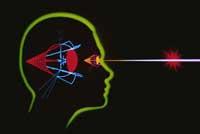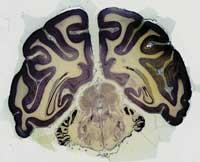The uncertain brain dazzles you
2001/06/14 Galarraga Aiestaran, Ana - Elhuyar Zientzia

Yoram Bonneh and his team at the Smith-Kettlewell Visual Research Institute in San Francisco analyzed what people saw before a peculiar image in which, among many blue dots constantly moving in the form of a whirlwind, several points stood. Most of those who looked at the picture saw these spots flicker. Likewise, the momentary disappearance of these points only occurs in the brain of the spectators. (If you want to try click here)
Apparently, the brain has a clear pattern of the appearance of the world. For the elaboration of this model, it makes a selection of the mixed data collected through the senses. When the sensations received are contradictory, some are abandoned.
This is what happens with the blindness caused by movement, that is, the brain leaves some of the information. According to the researchers, the same happens with many everyday situations, although people do not realize it. For example, those who look at the light of cars at night on a motorway will find that a fixed street light disappears (as the yellow dot disappears in the image used in the research).

For neurologist Jack Pettigrew, this sense of disappearance is due to the struggle between the left and right of the brain. If the pulse is set in the right hemisphere, the left hemisphere is responsible and the yellow dots disappear. On the contrary, if the right hemisphere is ordered (the magnetic pulse applied in the left hemisphere), the points reappear.
It seems that the left hemisphere rejects sensory information that does not correspond to the world model. The right hemisphere, for its part, sees the world as it is. For example, some disabled people with the affected right hemisphere deny their paralysis.
According to the researchers, the model or worldview is located in the cerebral parietal lobe. Some patients with this affected area find that things (for example, their feet) go away from sight. Others cannot perceive more than one thing at the same time. Research on the blindness caused by the movement helps to understand these situations.

Gai honi buruzko eduki gehiago
Elhuyarrek garatutako teknologia





